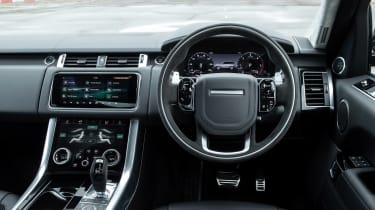Range Rover Sport review - interior and tech
Once cutting edge, the interior tech is a generation behind. Feel and ambiance is still lovely though
Despite the Range Rover Sport’s age the interior is still fabulous, characterised by sumptuous high-quality materials and a sense of occasion that’s missing in German rivals. The seats are plush and comfortable and the dash is laid out simply with a slick integration of tech, even if it is a generation or two behind some rivals.
Alongside the Sport’s mid-cycle update in 2018 came a new lower touchscreen interface, which controls the air-conditioning and heated seats, while also extending operation of the Terrain Response system. On the whole it works well, with clear press points and a pleasing lack of menus. The physical control turn knobs integratied into the screen itself is a nice detail and most other operations are carried out via the sat nav and media function touchscreen above.
The main bugbear is the infotainment system itself, which uses older software rather than the new Pivi system being rolled out across the range. In isolation, it does an acceptable job, but compared to equivalent systems in any of its rivals from Audi, BMW, Porsche or Mercedes, it is inescapably old hat in its appearance and speed of operation.
Aside from a gear selector borrowed from the Jaguar F-type, there are no real visual flourishes to acknowledge this Range Rover’s sporting remit inside. Instead the difference is felt in your position within the cabin, with a slightly lower seat, narrower windows and a less imperious view over the bonnet. That’s not necessarily a criticism; everything is well appointed, the driving position feels infinitely adjustable and space is abundant, to the benefit of practicality and comfort. Four adults will have more than enough room, five if the extra occupant isn’t too tall. The Sport also trumps the standard Range Rover by offering a ‘5+2’ seven-seat option, though the rearmost pews are aimed at children.



